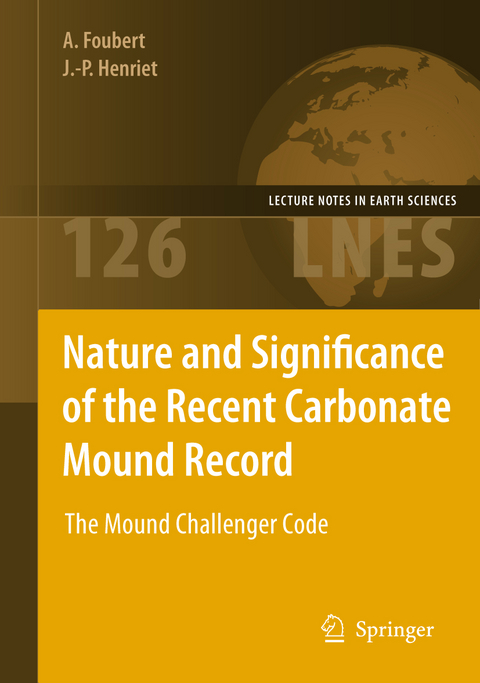Nature and Significance of the Recent Carbonate Mound Record
Springer Berlin (Verlag)
978-3-642-00289-2 (ISBN)
Carbonate mounds are an important feature along the European North-Atlantic margins. The presence of giant carbonate mounds in the Porcupine Seabight, on the Porcupine Bank, in the Rockall Trough and on the Rockall Bank, west of Ireland, have been known since the nineties and have been the target of several cruises during the last decade. However, the processes of mound build-up and mound nucleation are not yet completely understood. What keeps a mound growing over extended time periods? How does the biosphere interact with sedimentary fluxes to make a mound grow? On which level do palaeoclimatological and palaeoceanographic changes control mound growth? Which diagenetic processes play an important role in carbonate mound generation and how do they affect the mound?
The present study focuses on the nature and significance of the carbonate mound record, and the nature and internal structure of one specific carbonate mound, the Challenger Mound, is described in detail and compared with other mounds from the Irish margin and also with those from the Moroccan margin. The variety of mound characteristics are discussed, along with the associated oceanographic and geological settings and an appropriate classification for recent carbonate mound systems and cold-water coral reefs is presented. Video imagery through Remotely Operated Vehicle (ROV) surveys, provide images of the surface of different carbonate mounds to highlight morphological characteristics of the mounds.
The role of recent carbonate mounds, such as Challenger Mound, in the global carbonate budget is discussed along with inferences on how recent carbonate mounds can be seen as analogues of ancient mud mound systems.
Dr. Anneleen Foubert - MSc degree in geology, option marine geology (greatest distinction) at Ghent University (Belgium, 2002). Laureate Award Prof. Valère Billiet and Geologica Belgica Award for best MSc thesis (Belgium, 2002). PhD grant FWO-Flanders on cold-water coral reefs and carbonate mounds along the European Continental margins (2003-2007). Participation in numerous scientific campaigns from the Norwegian margins to the North-African margins. Major responsibility in the preparation of the Integrated Ocean Drilling Program (IODP) Leg 307 "Modern Carbonate Mounds: Porcupine Drilling" aboard the R/V Joides Resolution. Active in stimulating educational activities to bring science into classrooms (such as class@poles, class@oceans). PhD degree of Doctor in Geology "Nature and Significance of the Carbonate Mound Record" (May, 2007) Carbonate sedimentologist at the CSTJF (Technical and Scientific Centre Jean Feger) from TOTAL S.A. in Pau, France (Geoscience Technologies, Dept. of Structural Geology, Sedimentology and Geology Laboratory, Carbonate Sedimentology Group) (2007 - 2008) Post-doctoral lecture position at the Department of Earth and Environmental Sciences of the K.U. Leuven in Belgium (emphasis on diagenesis and petrophysical characteristics of mound/reef systems and dolomites) (from October 2008 on). Prof. Dr. Jean-Pierre Henriet - Graduated as Magister in applied geophysics at Aarhus University (Denmark,1970) and as PhD in geology (1974) at Ghent University, Belgium. - Founder of marine geology and geophysics at Ghent University (1976). - Professor in marine geology and geophysics, director of the Renard Centre of Marine Geology (RCMG). - Founder of the Erasmus Network Mercator in marine geology (1987). - Director of the Département Géosciences Marines of IFREMER in Brest (1990-1995). - President of the European Association of Exploration Geophysicists (1991). - Founder and first Chairman of the EAGE-PACE Foundation (1993-1995). - Vice-President of the Société Géologique de France (2007). - Member of the Royal Academy for Science and the Arts of Belgium, Class of Natural Sciences. - Pioneered Modern mound Research: discovery of major carbonate mound provinces in Porcupine Seabight 1997 (Nature 1998), first EC-sponsored international conference on carbonate mounds in Ghent 1998. Co-ordinator of projects on carbonate mound research at the EC (GEOMOUND), ESF (EUROCORES EuroDiversity project, MiCROSYSTEMS) and national levels (GeNesis), and partner in a few more. Lead Scientist of IODP proposal 573 (Challenger Mound Drilling) and first Co-Chief Scientist in the preparatory phase of IODP Exp. 307 (January-April 2005). Lead Scientist of IODP proposal 673 (Morocco Mound Drilling). Promotor/co-promotor of 10 PhD’s related to modern carbonate mound research at Ghent University.
Of Mounds and Cold-Water Corals.- Challenger Mound: A Case Study.- Imaging.- Geophysical and Geochemical Core Logging.- Magnetic Record of a Carbonate Mound.- The Top of the Record: On-Mound and Off-Mound.- Surface Processes.- Carbonate Mounds in the Gulf of Cadiz.- Conclusions and Outlook.
| Erscheint lt. Verlag | 7.7.2009 |
|---|---|
| Reihe/Serie | Lecture Notes in Earth Sciences |
| Zusatzinfo | XX, 298 p. 155 illus., 44 illus. in color. |
| Verlagsort | Berlin |
| Sprache | englisch |
| Maße | 155 x 235 mm |
| Themenwelt | Naturwissenschaften ► Biologie ► Limnologie / Meeresbiologie |
| Naturwissenschaften ► Biologie ► Ökologie / Naturschutz | |
| Naturwissenschaften ► Geowissenschaften ► Geologie | |
| Schlagworte | biosphere • Carbonate mounds • Carbonate sedimentology • Cold water corals • coral reef • diagenesis • fluxes • ocean • reefs • Sediment • Seen |
| ISBN-10 | 3-642-00289-7 / 3642002897 |
| ISBN-13 | 978-3-642-00289-2 / 9783642002892 |
| Zustand | Neuware |
| Haben Sie eine Frage zum Produkt? |
aus dem Bereich




